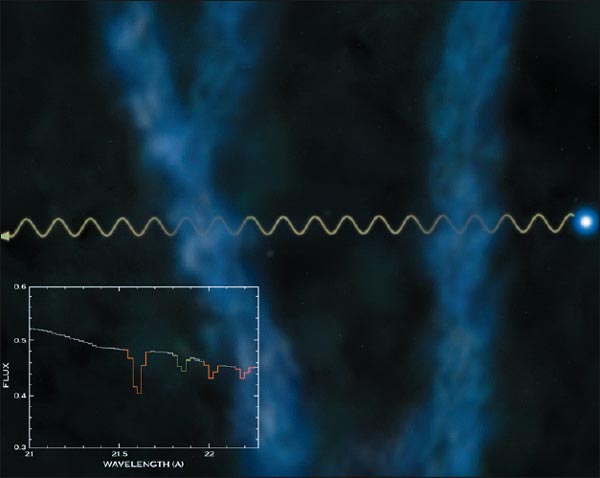While it is well known that ordinary baryonic matter constitutes only about 5% of the total energy content of the universe, it is probably less commonly appreciated that about half of this “known” matter has never been identified, even in our galaxy’s neighbourhood. Now a high-resolution spectrum from the Chandra X-ray Observatory suggests that the missing matter is in the form of diffuse, hot gas, filling vast regions between galaxies.

Baryons – the three-quark particles such as protons and neutrons – are used to define ordinary matter, because the other known particles are either like pions, too short-lived, or like electrons, too light to contribute significantly to the mass of the universe.
The masses of all astronomical objects that have been identified so far by different means are included in this baryonic mass – in particular, planets, stars of all types and black holes, as well as gas and dust – in other words, all the known constituents of galaxies.
According to cosmologists, however, all this amounts to only about half of the existing baryonic matter in the universe, which is itself only about 5% of the matter-energy content of the universe. The remaining 95% seems to consist of about 25% non-baryonic dark matter (see CERN Courier November 2004 p13 ) and the balance is dark energy (see CERN Courier September 2003 p23 ).
While the nature of dark matter and dark energy remains unknown, Fabrizio Nicastro from the Harvard-Smithsonian Center for Astrophysics and colleagues now claim that they have identified the missing part of baryonic matter. They have evidence that the elusive baryons are in the form of low-density “warm-hot” intergalactic gas, with a temperature of approximately 1 million degrees. The temperature and very low density of the gas have meant that it has previously escaped detection.
The team did not detect emissions from the gas, but rather absorption by the gas of X-ray radiation from an active galaxy along its line of sight. A strong outburst from the relatively nearby blazar Markarian 421 gave the team an opportunity to obtain the best signal-to-noise spectrum ever measured by the Chandra X-ray Observatory.
A detailed analysis of this spectrum revealed the presence of absorption lines that were identified as being those of highly ionized carbon, nitrogen, oxygen and neon: the most abundant nuclei in the universe besides helium and hydrogen.
Nine of a total of 24 absorption lines belong to two separate regions at distances of 150 million and 380 million light-years, as determined from the measured redshifts of the lines z = 0.011 and z = 0.027, respectively. The remaining lines are at a redshift of zero and are therefore associated with gas in our galaxy or in the local group of galaxies.
By assuming that the detected gas has a heavy-element abundance that is one-tenth of that of the Sun, which is typical for intergalactic gas, Nicastro and colleagues were able to extrapolate the total density of baryons along the line of sight to Markarian 421. The result is consistent with the amount of missing baryonic matter and with data from computer simulations.
Indeed, before the detection of this intergalactic gas, simulations of the large-scale structure formation predicted the existence of a warm-hot diffuse gas. This gas, one-millionth of the density of the interstellar medium in our galaxy, is shock-heated by the continuous interaction between galaxies.
The overall baryon content of this warm-hot gas is quite loosely determined by this first measurement, and certainly needs confirmation by similar studies along other lines of sight. Nevertheless, it is an important step on the track towards understanding the make-up of the universe.
Further reading
F Nicastro et al. 2005 Nature 433 495.
Author:
Compiled by Marc Türler, INTEGRAL Science Data Centre and Geneva Observatory







